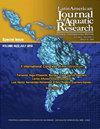Therapeutic, histopathological, and non-specific immune status effect of Rhizophora mangle and Laguncularia racemose hydroalcoholic extracts against Vibrio harveyi and Vibrio campbellii in white shrimp (Penaeus vannamei)
IF 0.8
4区 农林科学
Q3 FISHERIES
Latin American Journal of Aquatic Research
Pub Date : 2023-08-31
DOI:10.3856/vol51-issue4-fulltext-3051
引用次数: 0
Abstract
The objective of the research was to evaluate in vitro and in vivo antibacterial efficacy of Rhizophora mangle and Laguncularia racemose when added to the feed of Penaeus vannamei in an experimental infection with Vibrio harveyi (CAIM 1792) and V. campbellii (CAIM 333). Results show that the minimum inhibitory concentration for both extracts was 1.65 g mL-1, with an inhibition zone of 25 ± 1 mm (V. campbellii); 18 ± 2 mm (V. harveyi) for L. racemose and of 21 ± 2 mm (V. campbellii); 20 ± 2 mm (V. harveyi) for R. mangle. R. mangle gave a higher total content of phenolic compounds (4.50 ± 0.26 mg GAE mL-1) and flavonoids (2.60 ± 0.15 mg QE mL-1). The challenge with V. harveyi resulted in 70% survival for organisms fed L. racemose extract and 53% for R. mangle extract. The challenge with V. campbellii resulted in 80% survival for organisms fed L. racemose and 90% R. mangle. Histopathological alterations were observed in the hepatopancreas with hemocytic infiltration within the intertubular connective tissue. Also, tubules with severe cell detachment and tubular atrophy were detected in the positive control organisms, and organisms treated with R. mangle and L. racemose only had vermiform structures in the tubular lumen, cell detachment, and infiltration hemolymph in intertubular connective tissue. According to the analysis of the studied variables, it can be concluded that the hydroalcoholic extracts of R. mangle and L. racemose reduced mortality, clinical signs, and organs and tissue alterations and improved P. vannamei immunity. It is possible to use these hydroalcoholic therapeutic extracts as treatments in shrimp-farm to enhance bacterial disease tolerance and prevent mortality.mangle根霉和总状拉古菌水醇提取物对凡纳滨对虾(Penaeus vannamei)哈韦伊弧菌和坎贝尔弧菌的治疗、组织病理学和非特异性免疫作用
本研究的目的是评估将芒根霉和毛茛外消旋体添加到南美白对虾饲料中对哈维氏弧菌(CAIM 1792)和坎贝尔氏弧菌(CAIM 333)实验性感染的体内外抗菌效果。结果表明,两种提取物的最低抑制浓度均为1.65 g mL-1,抑制区为25±1 mm(V.campbellii);外消旋乳杆菌为18±2毫米(哈维氏乳杆菌),坎贝尔乳杆菌为21±2毫米;R.mangle为20±2mm(V.harveyi)。R.mangle的酚类化合物总含量(4.50±0.26 mg GAE mL-1)和类黄酮总含量(2.60±0.15 mg QE mL-1)较高。哈维氏乳杆菌的挑战导致以外消旋乳杆菌提取物为食的生物体存活70%,芒果乳杆菌提取物存活53%。campbellii病毒的攻击导致以外消旋乳杆菌和芒果乳杆菌为食的生物体存活80%。肝胰腺组织病理学改变,管间结缔组织内有血细胞浸润。此外,在阳性对照生物体中检测到具有严重细胞分离和小管萎缩的小管,并且用R.mangle和L.raceose处理的生物体在管腔中仅具有蠕虫状结构、细胞分离和管间结缔组织中的浸润性血淋巴。根据对研究变量的分析,可以得出结论,芒果和外消旋乳杆菌的水醇提取物降低了死亡率、临床症状、器官和组织改变,并提高了凡纳滨对虾的免疫力。使用这些水醇治疗提取物在对虾养殖场进行治疗是可能的,以提高细菌的抗病能力并防止死亡。
本文章由计算机程序翻译,如有差异,请以英文原文为准。
求助全文
约1分钟内获得全文
求助全文
来源期刊

Latin American Journal of Aquatic Research
FISHERIES-MARINE & FRESHWATER BIOLOGY
CiteScore
1.70
自引率
10.00%
发文量
44
审稿时长
4-8 weeks
期刊介绍:
Latin American Journal of Aquatic Research- LAJAR is the continuation of the journal Investigaciones Marinas (1970-2007) and is published since 2008 by the Escuela de Ciencias del Mar, Facultad de Ciencias del Mar y Geografía of the Pontificia Universidad Católica de Valparaíso. LAJAR is an “Open Access” journal that publishes in English language, original research articles, reviews and short communications on aquatic science, which contain the results of research conducted in aquaculture or in oceanic and coastal marine waters of Latin America.
The following topics are considered: Physical Oceanography, Chemical Oceanography, Marine Biogeochemistry, Marine Pollution and Toxicology, Marine Geology and Geophysics, Biological Oceanography, Fisheries and Aquaculture.
 求助内容:
求助内容: 应助结果提醒方式:
应助结果提醒方式:


